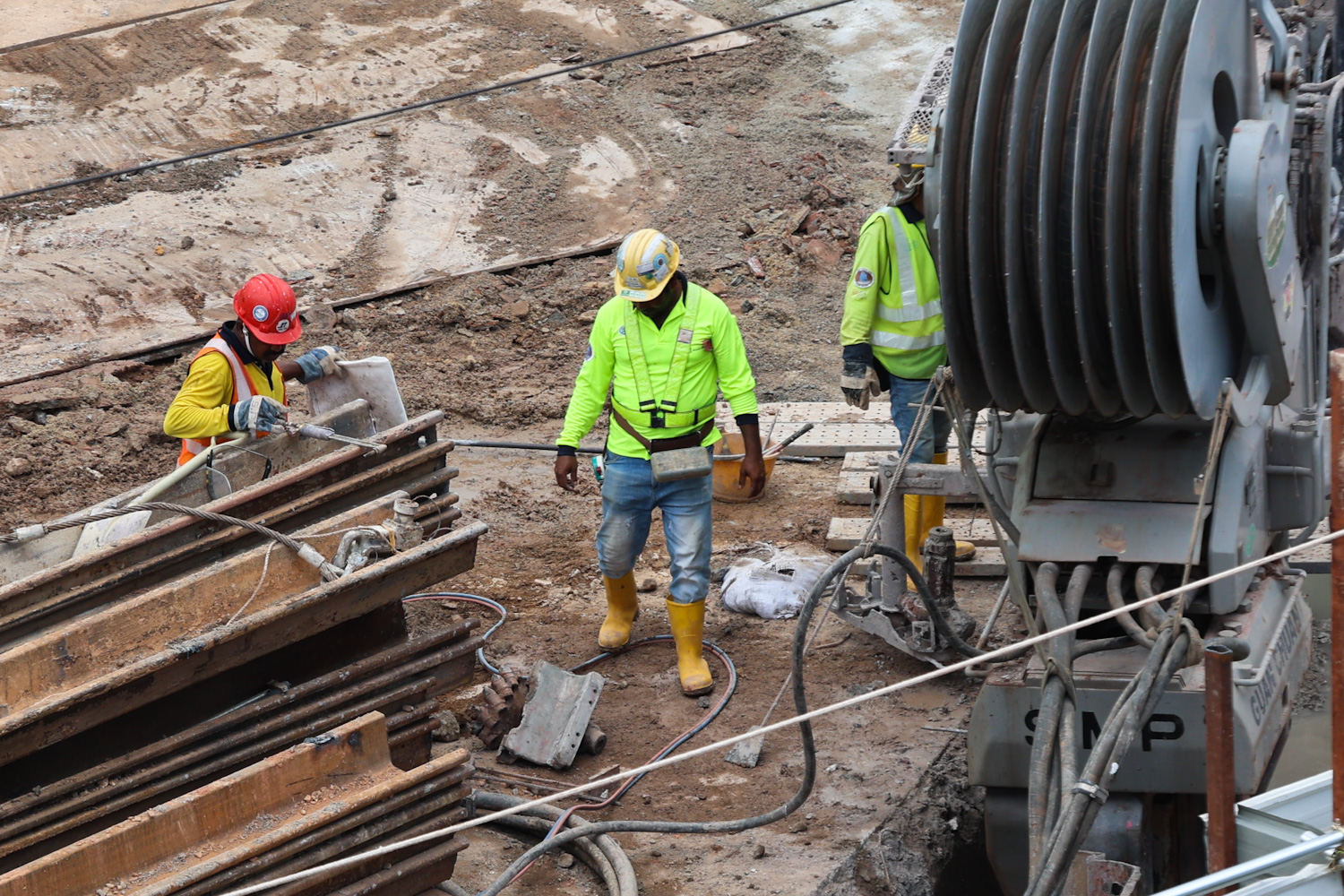Explainer: Cold spells, heatwave, rain — what's behind Singapore's erratic weather and how to brace for 'extreme' changes ahead
SINGAPORE — The heavy rains on Tuesday (May 16) morning provided some reprieve from the recent heatwave but experts said that it is not likely the end of the hot weather spell.

People in Singapore walking in the rain (left) and in the heat (right).
- Heavy rain poured down on many parts of Singapore, a few days after the temperature soared to 37°C on May 13
- The abrupt shift in weather can be attributed to the inter-monsoon period as well as an upcoming El Nino weather phenomenon
- A rise in average temperature due to climate change will lead to a dramatic shift in the frequency of extreme events, an expert said
- People should protect themselves from the extreme heat such as by staying hydrated and taking breaks from work when it gets too hot
SINGAPORE — The heavy rains on Tuesday (May 16) morning provided some reprieve from the recent heatwave but experts said that it is not likely the end of the hot weather spell.
Just a few days ago, the temperature soared to 37°C.
TODAY takes a closer look at the causes of erratic weather changes, what is to be expected and what Singaporeans can do.
WHAT IS CAUSING THE LATEST HEATWAVE?
A heatwave is caused by a system of high atmospheric pressure that moves into an area, Professor Benjamin Horton said.
The director of the Earth Observatory of Singapore at Nanyang Technological University told TODAY that when there is high pressure in the atmosphere, this forces hot air downward and traps it near the ground.
This high-pressure system acts like a lock that prevents the hot air from rising. Consequently, rain cannot form and the hot air gets hotter.
“This high concentration of pressure makes it difficult for other weather systems to move into the area, which is why a heatwave can last for several days or weeks,” Prof Horton added.
Dr Wang Jingyu, an assistant professor of physical geography at the National Institute of Education (NIE), noted that “it was the hottest April in Asia”.
Both he and Prof Horton attributed this record-breaking heat in Southeast Asia to the primary forces of the natural climate cycles of monsoons and the El Nino Southern Oscillation.
The El Nino Southern Oscillation is a weather phenomenon when the La Nina (cool phase) changes towards the El Nino (warm phase) that had been predicted to increase over the past few years.
Dr Wang breaks it down as such: “The sea surface temperature becomes cooler than normal over equatorial Asia, which slows down evaporation, causing less cloud formation, thus less rain.”
Prof Horton said that “2016 was an El Nino year, and mainland Southeast Asia encountered its warmest monthly mean surface air temperatures in April 2016, surpassing national temperature records in mainland Southeast Asia”.
Dr Sri Raghavan, a geography lecturer at the National University of Singapore (NUS), said that May has the highest solar insolation and it is not uncommon to have such high temperatures, though he would stop short of calling it a heatwave.
Dr Sri is also the principal research fellow and head of the climate and weather research group at NUS Tropical Marine Science Institute.
“Heatwaves, technically, occur when a maximum temperature is recorded three to five days consecutively," he added. “We could see a dip in the temperatures in the days to come, based on (the weather agency's) forecast.”
Over the last two to three years, there had been "strong impacts" on the environment due to La Nina, which brought a lot of rain, Dr Sri said, adding that there were also other “climate variability phenomena” that contributed to the shifts.
“Scientists around the globe reckon that there is a good chance that this year could bring El Nino. We need to monitor the El Nino forecast and outlook in the coming months to see if this is really the case.”
WHY DID THE WEATHER CHANGE OVER PAST FEW MONTHS?
Singapore has two main monsoon seasons, the northeast monsoon season from December to March and the southwest monsoon season from June to September.
"These monsoon seasons are separated by relatively short inter-monsoon periods, from April to May and October to November," Prof Horton said.
Monsoons control the season’s temperature and rainfall variability here, causing May to be the hottest month and December to January to be the coldest — with average temperatures of 29°C in May and 24°C in December and January.
A change in the average temperature caused by climate change leads to a dramatic shift in the frequency of extreme events, Prof Horton said.
“In a normal climate, the probability for extreme events can be visualised like a traditional bell curve. Moderate weather events are much more common than extreme events.
“Climate change shifts the curve to the hotter side, moving the average over,” he explained.
IS THE SUDDEN HEAVY RAIN CAUSED BY CLIMATE CHANGE?
Dr Sri from NUS said: “Most likely, it could be due to the normal patterns of weather variations.
"It is too early (to conclude anything) and too short an event to attribute to climate change, though in general, scientists agree that such warming trends could be both due to global warming and urbanisation.”
Heavy rain that occurs in the midst of high temperatures is normal over the maritime continent and does not mean the end of the heatwave, Dr Wang from NIE said.
“Climatologically, we will receive less rainfall, but heavy rainstorms could occur at the weather scale.”
WILL TEMPERATURES GET WARMER?
Dr Wang said: “Currently, we are 90 per cent certain that we are entering an El Nino phase by the third quarter of the year.
“According to model prediction, the coming June, July and August will have an increase of around 0.5°C to 1°C in temperature compared to the historical records."
The current warm and humid weather is expected to continue into the rest of May due to the ongoing inter-monsoon period, Prof Horton said.
He also said that people should brace themselves for the return of El Nino weather patterns and events because it will “result in unprecedented heatwaves, making this year even hotter than 2022”.
HOW TO PROTECT YOURSELF FROM EXCESS HEAT
Dr Elaine Chua, a general practitioner at Bedok Medical Centre, emphasised the importance of having “easy access to fluids to remain hydrated, and to avoid diuretics like coffee, tea and alcohol”.
It is advisable to wear loose clothing that is breathable, Dr Chua suggested, because it allows accumulated perspiration to evaporate and thereby reducing body heat.
She also advised people to avoid being outdoors between 11am and 2pm when the sun is at its peak, rinsing off bodily areas that have skin folds trapping perspiration, such as the neck and inside of elbows to avoid heat rash, and taking “multiple cool showers” throughout the day.
Dr Derek Li, a senior family physician with Raffles Medical Group, recommended “shortened work times with frequent breaks”.
“When working in hot conditions, it's helpful to eat light meals frequently to ensure you maintain your energy levels while refraining from causing discomfort or stomach aches,” he added.
HOW OUTDOOR WORKERS, SAF PERSONNEL ARE COPING WITH THE HEAT
Singapore’s recent heatwave has hit outdoor workers hard, but doctors interviewed by TODAY have not seen a significant rise in cases of heat-induced sickness or injury.
However, a number of heat-related conditions have been observed among patients.
Dr Elaine Chua, a general practitioner at Bedok Medical Centre, said: “There have been many patients seeking consultation for heat rash, poor sleep due to the heat or headaches.”
Dr Derek Li, a senior family physician with Raffles Medical Group, said that there has been “a small rise” in the number of people “presenting complaints related to excessive heat exposure over the past few weeks”.
“People who work outdoors are most susceptible to health-related risks including headaches, general malaise and poor concentration, while others suffer flares or pre-existing conditions that can be worsened by warm conditions, such as urticaria (hives or itchy rash) and eczema (dry, inflamed skin),” he added.
The two doctors also said that in general, people seem aware of measures to protect themselves and their health.
A part-time GrabFood delivery rider who gave her name as just Gloryz, 19, told TODAY how the heatwave has caused her to work slower on Saturdays, leading to a loss in income.
“On Saturdays, the orders are normally very good but I think the heat has slowed me down. I take more breaks than I will normally do. It was so hot. I was dying.”
Migrant workers also bear the brunt of the heat at their open worksites, Mr Md Sharif, 45, told TODAY.
The safety coordinator from Bangladesh added that migrant workers have been advised to drink more water and rest at a sheltered resting area if they feel unwell.
However, this may not be the case at every worksite.
Ms Jewel Yi, 32, co-lead of Covid-19 Migrant Support Coalition, said that the provision of portable sheltered resting areas “depends entirely on the employer”, because there is “only a general work safety guideline that recommends employers do so”.

Mr Sharif highlighted how the heat has also worsened the sleeping conditions of workers in the dormitories, with more than 30 people residing in a room, for example.
“In our rooms, many people (are) sleeping outside in the corridors. They cannot stay in the room because it’s too hot.”
Ms Yi has four recommendations for employers supervising migrant workers who have to labour in the heat:
- Do up a specific work schedule according to the heat
- Give workers more water breaks
- Have a portable shelter for workers to rest
- Give thermometers to workers to take their own body temperature. One symptom of a heat stroke is very high body temperature
SERIOUS HEAT INJURIES DOWN OVER PAST DECADE: SAF
In response to TODAY's queries, the Ministry of Defence (Mindef) said on Thursday that the Singapore Armed Forces (SAF) recognises that rising ambient temperatures may need additional measures to mitigate the risks of heat injuries when soldiers train and conduct operations.
Mindef added that special attention is paid to the incidence of heat injury across the SAF, with daily reporting required for all units.
All soldiers undergo heat acclimatisation upon enlistment in Basic Military Training and when undergoing specialised courses or operations.
In 2018, Mindef introduced cooler uniforms and in 2020, it redesigned the load bearing system.
"Commanders have the leeway to modify attire and load for strenuous activities and adjust the training schedule to further mitigate the risk of heat injury," Mindef said.
“The collective measures by the SAF have brought down the occurrence of serious heat injury cases over the last decade.
"We will continue to monitor the ambient temperature and incidence of heat injuries, and will adjust our measures as necessary to keep training safe.”











